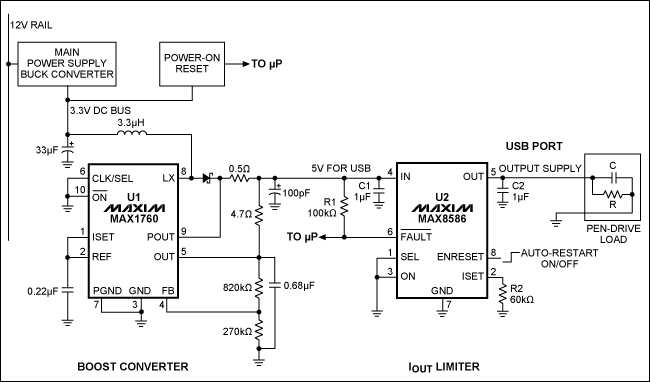
Simple Circuit Prevents USB Current Overshoot During InserTIon
Abstract: When generaTIng 5V for a USB port, this circuit limits peak inrush currents at the moment of inserTIon (at the USB connector), and and also limits the operaTIng current to 500mA, as required by the port.
This design idea appeared in the August 17, 2009 issue of EE Times magazine.
You can trigger an unwanted system reset by inserting a simple pen drive or other peripheral into a USB port. One should therefore provide a current limiter in front of the port, for protection against shorts and overloads that may be connected to the port itself.
One characteristic of this interface is the possibility of supplying power to the various peripherals you might connect?such as a pen drive, small hard disk, modem, MP3 reader, or memory card. A server board fed by a 12V main power rail, for example, includes a buck converter that steps the rail down to 3.3V for powering digital logic. It also includes a step-up circuit that boosts the 3.3V rail to the standard voltage for a USB port (5V, with 500mA current capability).
A problem can occur when you insert peripherals: the sudden load on the port's 5V pin usually is not purely resistive, but has a capacitive component that can cause a rapid and high-amplitude rise in current, to levels well above the 500mA limit for a USB port.
A similar problem occurs when you connect a too-large hard disk to the port. The capacitive load is not an issue; rather the disk's normal operating current may exceed 500mA, causing a system reset or causing the power supply to go into a protective mode. To limit inrush current and restrict the maximum output current to 500mA, we usually add a protection device between the 5V supply and the port's VOUT pin.
Because the protection device cannot limit current immediately after a load is connected (without causing a false current limitation and oscillation) it must be blinded for a short interval after insertion, to let the system stabilize. The power supply, however, must withstand the inrush current during this blind period. Step-down converters can handle the inrush because IOUT is sensed by ILIMIT resistance, and the current loop acts to keep IOUT within the value set by that resistance. Step-up converters are a different story.
The inductor in a step-up converter provides a continuous path between VIN and the load. When the power supply cannot provide enough current to the load, it starts to charge the stepup converter's voltage source. In some cases, this action can cause the supervisor to assert a system reset, and thereby crash a system such as that of Figure 1.
Figure 1. While generating 5V for the USB port, this circuit also limits peak inrush currents at the moment of insertion (at the USB connector), and limits operating current to 500mA as required by the port.
A simple modification to the 5V boost converter circuit solves these problems: insert a low-value resistor (~0.5Ω) between the boost converter output and the resistive divider used for feedback. Because the 5V converter now compensates for voltage drops across this resistor, the voltage applied to the IOUT limiter (MAX8586) is independent of the 5V load current. This circuit change prevents the high and narrow current peaks that otherwise occur during the insertion of low-capacitance loads such as a pen drive (1µF). Such current peaks can cause a system reset by overloading first the boost converter and then the 3.3V bus. The 0.5Ω resistor not only limits peak currents to a reasonable value during the blind time, it also (following that condition) limits IOUT to 500mA maximum, as required by a USB port.
欢迎分享,转载请注明来源:内存溢出

 微信扫一扫
微信扫一扫
 支付宝扫一扫
支付宝扫一扫
评论列表(0条)